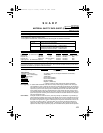
178
S H A R P
Date Revised:
Date Issued : May. 28, 1999
MATERIAL SAFETY DATA SHEET (2/2)
MSDS No. B-1020
Signs and Symptoms of Exposure : No symptoms expected with intended use.
Medical Conditions Generally Aggravated by Exposure : None
Emergency and First Aid Procedures :
Inhalation- - - If symptoms are experienced, remove source of contamination or move victim to fresh air and obtain medical
advice.
Ingestion
- - - If irritation or discomfort occurs, obtain medical attention immediately.
Skin
- - - - - - - Flush with gently flowing water (preferably lukewarm) and soap for 15 minutes or until particle is removed. If irri-
tation does occur, obtain medical advice.
Eye
- - - - - - - Do not allow victim to rub eye(s). Flush with gently flowing water (preferably lukewarm) for 15 minutes or until
particle is removed. Have victim look right and left, and, then up and down. If irritation does occur, obtain medi-
cal attention. DO NOT attempt to manually remove anything stuck to the eye(s).
Section 6. Physical Chemica l Characteristic s
Boiling Point : Not applicable Odor : Faint odor
Melting Point : No data available Specific Gravity : 1.2
Vapor Pressure : Not applicable Solubility in Water : Negligible
Vapor Density : Not applicable PH : Not applicable
Evaporation Rate : Not applicable Viscosity : Not applcable
Appearance : Powder Color : Black
Section 7. Fire and Explosion Data
Flash Point (Method Used) : Not applicable
Ignition Temperature :450
°
C * (* = Based on data for other products with similar ingredients)
Flammable Limits : (LEL):No data available(UEL): No data available
Extinguishing Media : CO2, water spray, foam and dry chemical
Special Fire Fighting Procedure :None
Unusual Fire and Explosion Hazard : If dispersed in air, like most finely divided organic powders, may form an
explosive mixture.
Sensitivity to Mechanical Impact : No data available
Sensitivity to Static Charge : No data available
Section 8. Reactivity Data
Stability :Stable
Incompatibility (Material to Avoid) : Oxidizing materials
Hazardous Decomposition : CO, CO2
Hazardous Polymerization : No data available
Section 9. Precautions for Safe Handling and Use
Personal Protection Information (Respiratory, Eye Protection and Protective Glove) : None required with intended use.
Engineering Control / Ventilation : None required with intended use.
Work / Hygienic Practice : Wash hands after handling. Try not to disperse the particles.
Steps to be taken in case of Spill or Leak : Wipe off with paper or cloth. DO NOT use vacuum cleaner. If a large
amount is released. It may create a dust explosion as would most finely
divided organic powders.
Waste Disposal Method : Waste material may be disposed under conditions which meet all fed-
eral, state and local environmental regulations.
Section 10. Regulatory Information
NFPA Rating (U.S.A.) : Health : 1 Flammability : 1 Reactivity : 0
WHMIS Legislation (Canada) : Not applicable
Transport Information :None
UN No. :None
Section 11. Other Information
References : IARC(1996), IARC Monographs on the Evaluation of the Carcinogenic Risk of Chemicals to Humans, Vol. 65,
Printing Process and Printing Inks, Carbon Black and Some Nitro Compounds, Lyon, pp-149-261
H. Muhle, B. Bellmann, O. Creutzenberg, C. Dasenbrock, H. Ernst, R. Kilpper, J. C. Mackenzie, P. Morrow, U. Mohr, S.Tak-
enaka, and R. Mermelstein (1991) Pulmonary Response to Toner upon Chronic Inhalation Exposure in Rats. Fundamental
and Applied Toxicology 17, pp. 280-299
MSDS.fm Page 178 Friday, December 1, 2000 8:45 AM


















